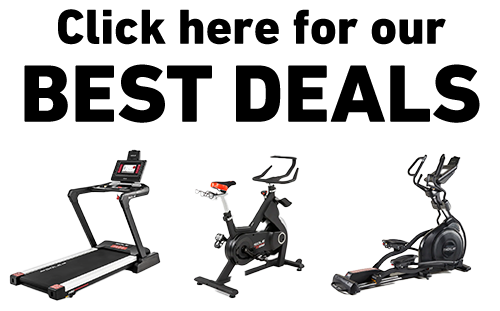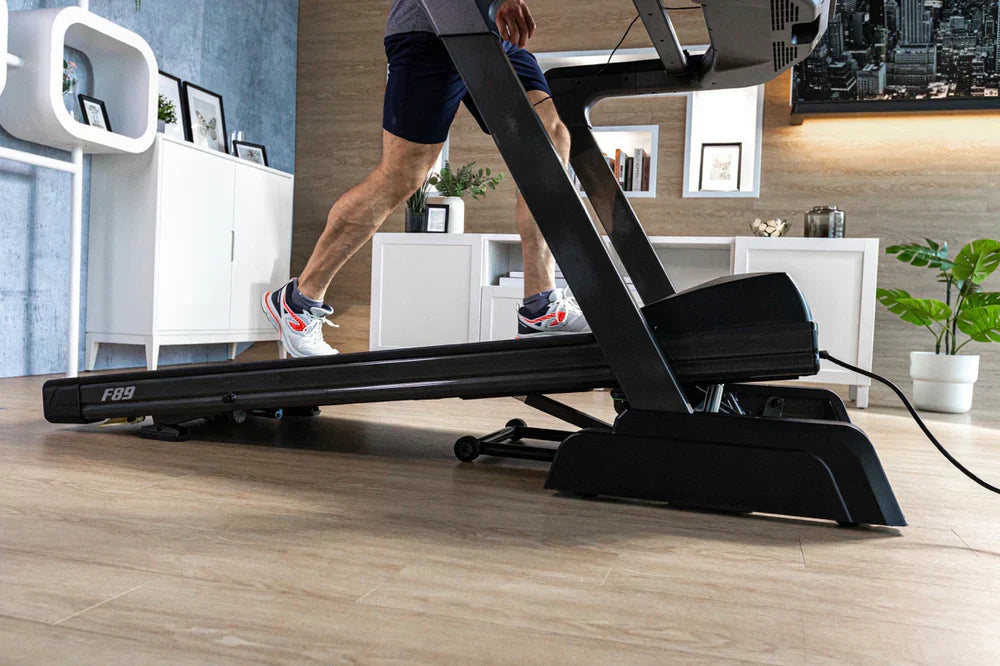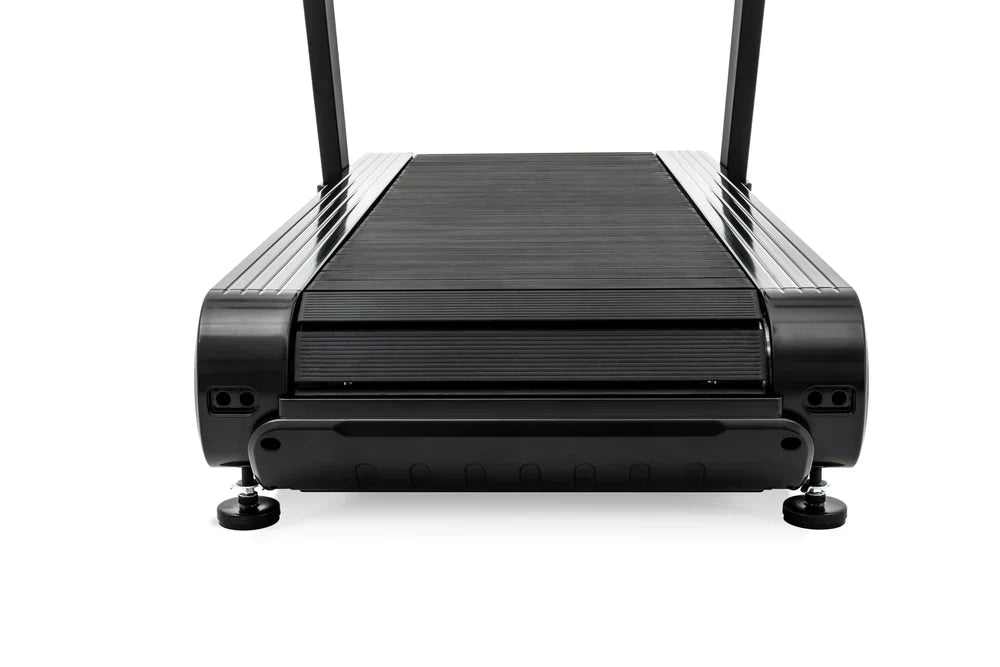Key Takeaways
- Lubricate your SOLE treadmill every 90 hours of use or every 3 months for optimal performance.
- Monitor the console "Lube" indicator, increased noise, and friction as key signs your treadmill needs lubrication.
- Use only SOLE-approved silicone-based lubricant to prevent damage to critical components.
- Comprehensive maintenance includes regular cleaning and systematic belt alignment monitoring.
- Regular lubrication significantly extends the lifespan of your SOLE treadmill investment.
Why Proper Maintenance Is Essential for Your SOLE Treadmill
Though SOLE belts and decks come pre-lubricated, ongoing maintenance ensures that your treadmill performs optimally, reduces the risk of component damage, and maximally extends its lifespan. Also, proper care helps you avoid costly repairs over time.
Running on a treadmill that produces noise and operates roughly with each step can be frustrating and is also a sign of wear and tear that could lead to more serious issues, which makes proper maintenance critical for long-term reliability.
Benefits of Regular Lubrication
- Lubrication eliminates friction between the belt and deck, enabling smoother operation
- By reducing friction, lubrication prevents the motor and other components from overheating and failing prematurely
- Regular lubrication can extend the life of your treadmill, making it a highly worthwhile time investment
- A well-lubricated treadmill operates more efficiently, providing a superior workout experience, whether you want to enhance your cardiovascular fitness, lose weight, or build muscle strength
|
Award-Winning Commercial-Grade Treadmills for Your Home
Why Choose SOLE: ✓ Commercial-grade steel frames with up to 4.0 HP motors 30-Day Money-Back Guarantee: Love it or return it, no questions asked. |
Key Indicators for SOLE Treadmill Lubrication

Recognizing maintenance signals helps prevent minor lubrication issues from becoming major mechanical problems.
Understanding when to lubricate your treadmill is just as important as the procedure itself. Here are critical signs to monitor:
Console "Lube" Indicator
Most SOLE treadmills feature a useful maintenance reminder: the console "Lube" indicator. This notification will activate after 90 hours of use, alerting you that lubrication is required. Ignoring this indicator can result in increased wear and component damage.
Checking for Adequate Lubrication Between Belt and Deck
Inspect the lubrication between the belt and deck monthly. If you find that the area between the belt and the deck feels dry, it's a definitive sign that lubrication is needed, even if the "Lube" indicator isn't activated on the console. A dry deck increases friction, forcing the motor to work harder and potentially causing damage.
Increased Noise and Friction
Another clear sign is increased noise and friction. If your treadmill begins making more noise than normal or if you experience more resistance while training, it's time to lubricate. This preventive action can avoid further damage and ensure a smoother workout experience.
Step-by-Step Guide to Lubricate SOLE Treadmills

Following these precise lubrication steps ensures proper maintenance while preventing over-application that could damage components.
Materials Needed
Before you start, gather the required materials:
- SOLE-approved silicone-based lubricant
- A clean, non-fraying cloth (e.g., microfiber towel, t-shirt, or light towel)
- Allen wrench (usually provided with the treadmill)
Having these materials available will make the process more efficient and effective.
Preparation Steps
- Ensure your treadmill is turned off and unplugged before you begin.
- Locate the area halfway between the end of the treadmill and the motor cover, then push the lint-free cloth under the belt until you can grasp it on both sides.
- Drag the cloth along the entire belt length 1–2 times, then remove it. This process will help remove any dust or debris that may be trapped.
- Use the Allen wrench to loosen the rear roller adjustment bolts on both sides. It usually takes about 5–10 turns to loosen the walking belt. This will provide better access to the deck for lubrication.
Lubrication Process
- Measure 18 inches from the edge of the motor cover, then position yourself and reach under the belt about 4–6 inches from one edge
- Apply a line of lubricant about 1/8 inch wide and 15 inches long in an "S" pattern perpendicular to the motor cover, where your feet typically make contact
- Repeat the application process on the opposite side
Post-Lubrication Procedure
After you've completed the lubrication process, perform a post-lubrication verification. This ensures that everything operates properly and that the lubricant is evenly distributed.
- First, tighten the belt using the Allen wrench. Make sure it's snug but not overly tight
- Next, plug the treadmill back in and activate it
- Set it to a slow walking speed (approximately 6mph) and walk on it for about five minutes. This helps evenly distribute the lubricant across the deck and belt
- Monitor how the treadmill feels and sounds. If everything operates smoothly and quietly, you've completed the procedure successfully. If you notice any issues, such as uneven movement or unusual noises, you may need to readjust the belt or add additional lubricant
Comprehensive Maintenance Tips for SOLE Treadmills
Regular Cleaning Procedures
Cleaning your treadmill consistently helps prevent dust and debris from accumulating, which can cause wear and component damage. Clean the console, handrails, and belt after each use with a damp cloth. For a more thorough cleaning, use a mild detergent and water solution, but avoid harsh chemicals that could damage the equipment.
Belt Alignment Monitoring
Maintaining proper belt alignment is essential for smooth operation. To check the alignment, activate the treadmill at a slow speed and observe the belt's position. If it drifts to one side, use the adjustment screws at the back of the treadmill to center it. This simple maintenance check can prevent uneven wear and extend the life of your belt.
Systematic Wear and Tear Assessment
Consistently inspect your treadmill for signs of wear and deterioration. Look for frayed edges on the belt, unusual noises, or any components that seem loose. Addressing these issues promptly can prevent more significant problems later.
Monthly and Quarterly Maintenance Schedules
In addition to regular use-based tasks, incorporate monthly and quarterly maintenance procedures:
- Monthly: Check and tighten any loose screws or bolts. Inspect the power cord for any damage.
- Quarterly: Perform a thorough inspection of the motor area. Clean and vacuum any dust or debris that may have accumulated.
Potential Issues from Over-Lubricating SOLE Treadmills

Systematic maintenance practices ensure your SOLE treadmill investment delivers years of reliable, high-performance training.
Excessive Lubricant Buildup
Applying too much lubricant can cause accumulation on the treadmill deck and belt. This can cause the belt to slip or interfere with components, which compromises the treadmill's performance. Always follow SOLE's specifications for the correct amount of lubricant to use.
Impact on Motor and Belt Performance
Over-lubrication can also negatively impact the motor and belt function. Excess lubricant can seep into the motor, causing it to overheat or malfunction. It can also make the belt too slippery, reducing traction and increasing the risk of accidents.
Cleaning Up Excess Lubricant
If you accidentally apply too much lubricant, you can clean up the excess by wiping down the deck and belt with a clean cloth. Run the treadmill at a slow speed for a few minutes to help distribute any remaining lubricant evenly.
Protect Your SOLE Treadmill with Professional Maintenance

Maintaining your SOLE treadmill is essential for its longevity and performance.
Following our comprehensive lubrication and maintenance guide protects your treadmill while maintaining the commercial-grade performance that sets SOLE apart.
Our systematic 90-hour lubrication schedule prevents the friction-related motor failures that plague consumer-grade equipment, while our pre-lubricated belts and precision-engineered components require less frequent maintenance than inferior alternatives.
SOLE's advanced console "Lube" indicator takes the guesswork out of maintenance timing, while our SOLE-approved silicone lubricant is specifically formulated to work with our commercial-grade belts and deck materials.
This precision matching ensures optimal performance of all our models, including the F85, F89, F63, F65, and ST90, and prevents the component damage that generic lubricants can cause.
SOLE's lifetime frame warranties and extended motor coverage reflect our confidence in superior engineering, but proper maintenance ensures you realize the full potential of this quality construction.
Follow this guide consistently, and your SOLE treadmill will provide the dependable performance that makes achieving your fitness goals both possible and enjoyable!
Shop the SOLE Equipment Lubricant!
Frequently Asked Questions (FAQs)
How often should I lubricate SOLE treadmills?
You should lubricate your SOLE treadmill every 90 hours of use or every 3 months, whichever comes first. Alternatively, for light/moderate use (1–3 users, 10 hours/week or less), lubricate 1–2 times per year. For heavy use (2+ users, 10+ hours/week), lubricate 2–4 times per year
What type of lubricant is best for a SOLE treadmill?
Use only SOLE-approved silicone-based lubricant; it’s specifically formulated to reduce friction between the treadmill belt and deck, ensuring smooth operation while being compatible with SOLE's commercial-grade materials. Generic lubricants can damage SOLE's precision-engineered components and void warranty coverage.
What happens if I don't lubricate my treadmill?
If you don't lubricate your treadmill, increased friction can cause the motor to overheat and components to wear out significantly faster, leading to costly repairs. Also, belt damage from inadequate lubrication can compromise safety and require complete belt replacement.
Can I use any lubricant for my SOLE treadmill?
No, it's essential to use SOLE-approved silicone-based lubricant to avoid damaging the treadmill and maintain warranty coverage. Other lubricants may contain chemicals that degrade SOLE's belt materials or create excessive buildup that interferes with proper operation.
How do I know if my treadmill needs more frequent lubrication?
Signs that your treadmill may need more frequent lubrication include increased noise, friction, and a dry feeling between the belt and deck. Additionally, if you use your treadmill in dusty environments, at high temperatures, or for particularly intensive training sessions, you may need to lubricate more frequently than the standard schedule to maintain optimal performance.




Leave a comment
This site is protected by hCaptcha and the hCaptcha Privacy Policy and Terms of Service apply.